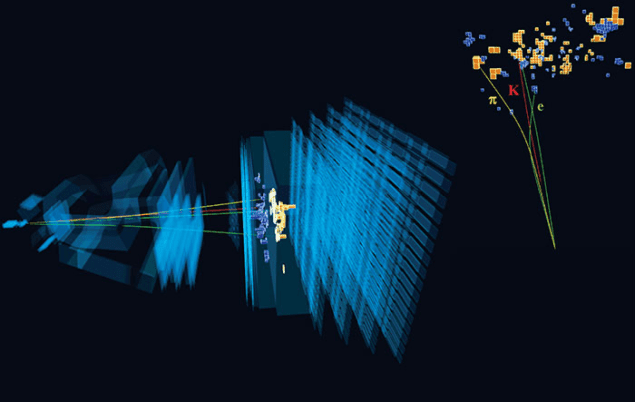
A hint of the possible existence of a hypothetical particle called a leptoquark has appeared as an unexpected difference in how beauty quarks decay to create electrons or muons. Measured by physicists working on the LHCb experiment on the Large Hadron Collider (LHC) at CERN, the difference appears to violate the principle of “lepton universality”, which is part of the Standard Model of particle physics. The measurement has been made at a statistical significance of 3.1σ, which is well below the 5σ level that is usually considered a discovery. If the violation is confirmed, it could provide physicists with important clues about physics beyond the Standard Model – such as the existence of leptoquarks.
When high-energy protons are smashed together at the LHC large numbers of exotic particles are created, including some containing the beauty quark. These exotic particles quickly decay, and beauty quarks can follow decay paths that involve the production of either electrons or muons, which are both leptons. According to the Standard Model of particle physics, the interactions involved in producing leptons do not discriminate between lepton type, so the rates at which electrons and muons are created by beauty-quark decays are expected to be the same.
Starting in 2014, physicists working on LHCb noticed hints of the violation of this lepton universality. Now, after analysing collision data collected between 2011 and 2018, the researchers have found that the beauty quark appears to favour the electron decay chain over the muon decay chain.
New particle
The decay process involves the conversion of a beauty quark into a strange quark with the production of an electron and antielectron or a muon and antimuon. The Standard Model predicts that this occurs via electroweak bosons and the W+ and Z0 particles. However, violation of lepton universality suggests that there may be other ways for this to happen. One tantalizing explanation is the existence of a hypothetical particle called a leptoquark, which is a massive boson that couples to both leptons and quarks. In principle, leptoquarks could have different coupling strengths to electrons and muons.

Exotic hyperons interact with protons at CERN
While a new particle is an exciting proposition, physicists will have to wait until LHCb gathers more data in upcoming runs of the LHC to confirm the violation of the Standard Model. Team member Nicola Serra of the University of Zurich says “it is too early to draw a final conclusion. However, this deviation agrees with a pattern of anomalies that have manifested themselves over the last decade. Fortunately, the LHCb collaboration is well placed to clarify the potential existence of new physics effects in these decays. We just need many more related measurements in the future.”
The research is described in a preprint on arXiv.



